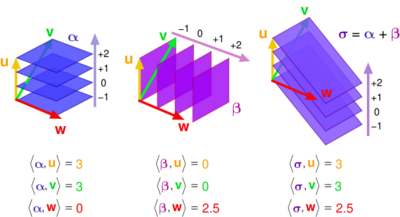One-form

In linear algebra, a one-form on a vector space is the same as a linear functional on the space. The usage of one-form in this context usually distinguishes the one-forms from higher-degree multilinear functionals on the space. For details, see linear functional.
In differential geometry, a one-form on a differentiable manifold is a smooth section of the cotangent bundle. Equivalently, a one-form on a manifold [math]\displaystyle{ M }[/math] is a smooth mapping of the total space of the tangent bundle of [math]\displaystyle{ M }[/math] to [math]\displaystyle{ \R }[/math] whose restriction to each fibre is a linear functional on the tangent space. Symbolically, [math]\displaystyle{ \alpha : TM \rightarrow {\R},\quad \alpha_x = \alpha|_{T_xM}: T_xM \rightarrow {\R} , }[/math] where [math]\displaystyle{ \alpha_x }[/math] is linear.
Often one-forms are described locally, particularly in local coordinates. In a local coordinate system, a one-form is a linear combination of the differentials of the coordinates: [math]\displaystyle{ \alpha_x = f_1(x) \, dx_1 + f_2(x) \, dx_2 + \cdots + f_n(x) \, dx_n , }[/math] where the [math]\displaystyle{ f_i }[/math] are smooth functions. From this perspective, a one-form has a covariant transformation law on passing from one coordinate system to another. Thus a one-form is an order 1 covariant tensor field.
Examples
Applications
Many real-world concepts can be described as one-forms:
- Indexing into a vector: The second element of a three-vector is given by the one-form [math]\displaystyle{ [0, 1, 0]. }[/math] That is, the second element of [math]\displaystyle{ [x, y, z] }[/math] is [math]\displaystyle{ [0, 1, 0] \cdot [x, y, z] = y. }[/math]
- Mean: The mean element of an [math]\displaystyle{ n }[/math]-vector is given by the one-form [math]\displaystyle{ \left[1/n, 1/n, \ldots, 1/n\right]. }[/math] That is, [math]\displaystyle{ \operatorname{mean}(v) = \left[1/n, 1/n, \ldots, 1/n\right] \cdot v. }[/math]
- Sampling: Sampling with a kernel can be considered a one-form, where the one-form is the kernel shifted to the appropriate location.
- Net present value of a net cash flow, [math]\displaystyle{ R(t), }[/math] is given by the one-form [math]\displaystyle{ w(t) = (1 + i)^{-t} }[/math] where [math]\displaystyle{ i }[/math] is the discount rate. That is, [math]\displaystyle{ \mathrm{NPV}(R(t)) = \langle w, R\rangle = \int_{t=0}^\infty \frac{R(t)}{(1+i)^{t}}\,dt. }[/math]
Differential
The most basic non-trivial differential one-form is the "change in angle" form [math]\displaystyle{ d\theta. }[/math] This is defined as the derivative of the angle "function" [math]\displaystyle{ \theta(x,y) }[/math] (which is only defined up to an additive constant), which can be explicitly defined in terms of the atan2 function [math]\displaystyle{ \operatorname{atan2}(y, x) = \operatorname{arctan}(y/x). }[/math] Taking the derivative yields the following formula for the total derivative: [math]\displaystyle{ \begin{align} d\theta &= \partial_x\left(\operatorname{atan2}(y,x)\right) dx + \partial_y\left(\operatorname{atan2}(y,x)\right) dy \\ &= -\frac{y}{x^2 + y^2} dx + \frac{x}{x^2 + y^2} dy \end{align} }[/math] While the angle "function" cannot be continuously defined – the function atan2 is discontinuous along the negative [math]\displaystyle{ y }[/math]-axis – which reflects the fact that angle cannot be continuously defined, this derivative is continuously defined except at the origin, reflecting the fact that infinitesimal (and indeed local) changes in angle can be defined everywhere except the origin. Integrating this derivative along a path gives the total change in angle over the path, and integrating over a closed loop gives the winding number times [math]\displaystyle{ 2 \pi. }[/math]
In the language of differential geometry, this derivative is a one-form, and it is closed (its derivative is zero) but not exact (it is not the derivative of a 0-form, that is, a function), and in fact it generates the first de Rham cohomology of the punctured plane. This is the most basic example of such a form, and it is fundamental in differential geometry.
Differential of a function
Let [math]\displaystyle{ U \subseteq \R }[/math] be open (for example, an interval [math]\displaystyle{ (a, b) }[/math]), and consider a differentiable function [math]\displaystyle{ f: U \to \R, }[/math] with derivative [math]\displaystyle{ f'. }[/math] The differential [math]\displaystyle{ d f }[/math] of [math]\displaystyle{ f, }[/math] at a point [math]\displaystyle{ x_0 \in U, }[/math] is defined as a certain linear map of the variable [math]\displaystyle{ d x. }[/math] Specifically, [math]\displaystyle{ df(x_0, \cdot): d x \mapsto f'(x_0) dx. }[/math] (The meaning of the symbol [math]\displaystyle{ d x }[/math] is thus revealed: it is simply an argument, or independent variable, of the linear function [math]\displaystyle{ df(x_0,\cdot). }[/math]) Hence the map [math]\displaystyle{ x \mapsto df(x) }[/math] sends each point [math]\displaystyle{ x }[/math] to a linear functional [math]\displaystyle{ df(x,\cdot). }[/math] This is the simplest example of a differential (one-)form.
In terms of the de Rham cochain complex, one has an assignment from zero-forms (scalar functions) to one-forms; that is, [math]\displaystyle{ f\mapsto df. }[/math]
See also
- Differential form – Expression that may be integrated over a region
- Physics:Reciprocal lattice – Fourier transform of a real-space lattice, important in solid-state physics
- Tensor – Algebraic object with geometric applications
References
- ↑ Misner, Charles W.; Thorne, Kip S.; Wheeler, John Archibald (1973). Gravitation. San Francisco: W. H. Freeman. p. 57. ISBN 978-0-7167-0344-0.

